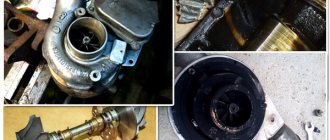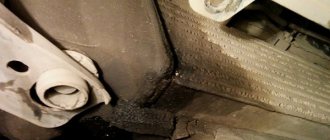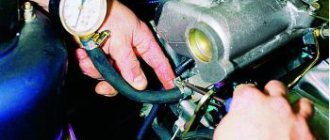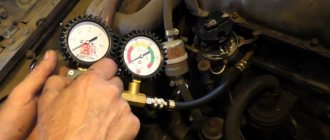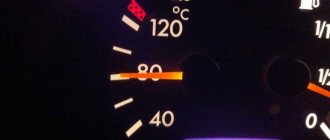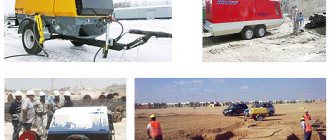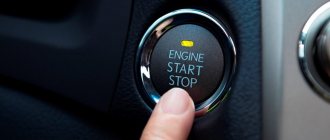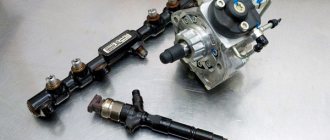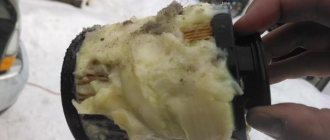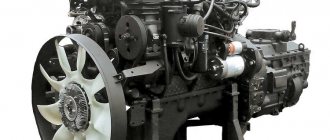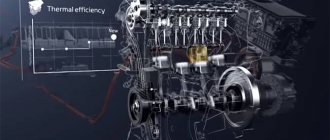How to check a turbine on a diesel engine?
In service centers, a scanner is usually connected to a special connector on the car to identify faulty operation of the turbine. Turning off the turbocharger can happen due to the injected air or due to the exhaustion of its own resource by the turbine. To determine the air pressure that is pumped during operation of the turbine, a special device with a pressure gauge must be connected to its output. The characteristics taken will make it clear that it is necessary to change the turbocharger one hundred percent or repair the turbine . At the same time, if you decide to buy a used turbine ( if the integrity of the turbine housing is damaged ), then contact our technical center. Specialists will help you choose the necessary model, which is 30-40% cheaper.
Checking boost pressure under load
Turbine operation
must be checked under load.
A normal turbine
should pump at least 0.9 kg/cm. with uv.
TD42T turbine pressure.
Turbine actuator
The TD42T does not fit into a left-handed 60, it rests on the steering cardan. The fastening has to be farmed
Video - the turbine throws oil into the intake
How Vasya checks the turbine (software)
The inspection methods described above only provide an indirect assessment of the condition of a used turbine. To diagnose it in detail, it is better to use electronic means - a laptop and diagnostic software installed on it. The most common program for this among masters and car owners is “Vasya Diagnostician”. The following is a brief description of the algorithm for checking the pressure in the tested turbine. It is assumed that the car enthusiast knows how to connect to the service connector of the ECU and run the program. All further readings are performed with the machine idling, that is, with the engine and turbine running.
Checking the turbine on the Vasya machine
It is recommended that before purchasing a used car, you check all its systems, including the turbine, not only visually and tactilely, but also using the described software tools like Vasya Diagnostic.
Causes of car turbine malfunction
The cause of turbine malfunction is the emission of blue exhaust smoke when the car accelerates, and at constant speed it disappears. This may be caused by the combustion of oil entering the engine cylinders due to a leak in the turbocharger.
Also, a malfunction in the TKR (turbocharger) control system may be indicated by black smoke appearing during the combustion of an enriched mixture due to air leakage in the injection lines.
White exhaust gases , on the contrary, indicate that the TKR oil drain line is clogged. An increase in oil consumption (0.2 - 1 liter per 1 thousand km) and the presence of leaks at the joints of the air path pipes and on the turbine are most likely due to contamination of the oil drain line or air channel.
The cause may also be coking of the TKR axle housing. Due to insufficient air supply from a faulty turbocharger, the acceleration dynamics of the car may deteriorate.
whistling while the engine is running , then the source of the problem may be an air leak at the junction of the motor output and the compressor.
Video - whistling on Mercedes-Benz Sprinter
If you hear a characteristic grinding noise during operation or notice cracks and deformation of the turbine housing, then be prepared for the fact that the TCR may soon fail.
The components that make up the turbocharging system: turbine, electronic pressure, air, oil sensors, line for air intake and transmission to the discharge pipeline, shut-off valve, etc. Many modern machines are equipped with automation systems that will immediately turn off the turbine if one of the listed systems fails. And this, in turn, will affect the ability to develop maximum engine power.
The ingenious idea of using exhaust gases to accelerate the rotor made it possible to create a turbocharged diesel internal combustion engine and increase its power by 40–50%. This is despite the fact that during normal operation, the emission of gases is accompanied by a decrease in efficiency within the range of 30 - 40%.
Simple check of the turbine on a car
Are you the owner of a turbocharged car? But you don’t have the technical knowledge to check the turbine correctly without contacting a specialized service center? Believe me, there are a large number of such car owners. We present to your attention instructions for checking (diagnostics) of the turbine for all occasions.
Checklist for checking the turbine
- You have to dismantle the pipes and inspect them externally. We are talking about the pipe that connects your turbine to the engine intake manifold or intercooler. An important indicator of quality is dryness inside, or very slight traces of oil. A situation may occur when the car engine consumes excessive oil. Many questions arise. What causes oil burn? Is it the engine, or is it the turbine, or are they both at fault? Where should the renovation begin?
- You will also need to visually inspect the turbine wheel. Or rather, its blades. It is important that there is no damage or surface deformation on them. They should be straight and have the correct factory appearance. Check carefully to see if there is a small gap there. If any internal or external damage to the blades is detected, you must immediately contact a turbine repair service.
- Try to move the shaft without much effort first in the direction of movement along the axis. It is necessary to feel minimal play or its absence (0-0.05 mm). Do not forget to give the shaft movement in the radial direction. The permissible value of movement backlash is from 0 mm to 1.0 mm. The shaft blades should not touch the volute if you move it to one of the extreme positions and rotate it. In both cases, when there is shuffling, grazing and greater play, the turbine must be repaired or replaced.
- Check the condition of the following components and parts: bearing housing, rotor, compressor wheel, oil slinger, flanges, turbine and compressor housings for any damage, cracks or problems. If at least one crack is detected, the turbine must be replaced or repaired.
- When the required power and traction are lost in the car, you should inspect the intake and exhaust manifolds. Most likely, this is a situation where there is no tightness. Moreover, if the fuel system in a diesel engine has ever been incorrectly adjusted, then power may also be lost. In gasoline engines, the problem may lie in incorrect settings of the automatic fuel supply system and settings of the ignition module. When any element of the boost level control system has the slightest malfunction, you can expect an increase in fuel consumption, a drop in traction, and a deterioration in dynamics. This is all a consequence.
High-quality turbine diagnostics using modern equipment can be carried out in the TURBOHELP turbine repair and sales workshop.
Source
Structural elements of the system
To carry out the assigned functions, the turbocharging system consists of two main parts:
The compressor is used to force atmospheric air into the fuel supply system. It consists of a housing and an impeller located in it, which rotates and sucks in air. The higher its rotation speed, the greater the volume of air received. The increase in speed is facilitated by the operation of the turbine.
It also consists of a housing with an impeller (rotor), which is driven by exhaust gases. In the housing, gases pass through a special channel shaped like a snail, which allows them to increase speed.
How does diesel engine turbocharging work?
The turbine rotor and the compressor impeller are rigidly mounted on the same shaft. Thus, the rotation speed of the rotor is transferred to the impeller. The circle closes:
- Through the compressor, air from the atmosphere, mixed with fuel, is supplied to the engine cylinders;
- The mixture burns, driving the pistons, and the resulting gases enter the exhaust manifold;
- Here they are received into the turbine housing, accelerated in the channel and at the exit interact with the rotor, causing it to rotate;
- The rotor transmits rotation through the shaft to the compressor impeller, which sucks atmospheric air into the housing.
An interconnected operating pattern is obtained, when the amount of intake air depends on the speed of rotation of the impeller and, conversely, the impeller rotates faster with a larger amount of intake air.
The principle of operation of turbocharging has two moments, called turbo lag and turbo boost.
The first moment is characterized by a delay in the operation of the turbine after increasing the fuel supply by pressing the gas pedal, since it takes time to accelerate the rotor with exhaust gases.
Following the turbo lag comes the moment of turbo boost, when the accelerated rotor sharply increases the air supply to the cylinders, increasing engine power.
Why does insufficient oil pressure form in the turbine?
The turbine oil supply system is entirely dependent on the engine oil supply system. The turbine does not fail on its own; it only fails in the event of other problems with the engine. That is why, if there is insufficient oil pressure in the turbine, then the operation of the entire oil supply system should be studied.
Possible causes of low oil pressure:
- The engine oil filter is clogged and needs to be replaced according to the regulations.
- The engine is filled with oil of the wrong viscosity.
- The oil has already exhausted its service life and requires replacement.
- The oil channels through which oil moves in the engine are clogged.
- Engine wear, chips and other dirt enter the system, which prevents the movement of oil.
- Problems with the high pressure oil supply pipe to the turbine.
After a comprehensive engine diagnostic is completed, a professional will be able to tell why insufficient oil pressure has formed inside the turbine. The most optimal way to solve the problem will also be proposed.
What are the consequences of insufficient oil pressure in the turbine?
During operation, the turbine rotates at a very high speed, this is necessary in order to create the necessary air pressure in the intake manifold. The higher the engine speed, the more gases are released into the exhaust manifold, the faster the first “snail” rotates and the faster the second one rotates. At the same time, as the speed increases, the oil pressure in the turbine also increases, because more of it is needed.
If at high speeds an insufficient amount of oil is supplied inside the turbine, it is quickly produced, and as a result, the shaft may jam. A sudden stop of the turbine during operation can destroy the blades and even the housing of the turbine itself, so expensive repairs or even replacement of the entire assembly will be required. It is necessary to constantly monitor the oil pressure in the turbine and engine; if problems arise, solve them immediately; further operation will lead to serious malfunctions.
Troubleshooting methods
First of all, if the oil has not been changed according to the regulations, then it must be done. It is also necessary to replace the engine oil filter, which may be clogged and thereby reduce the oil pressure in the system. If the engine is worn out, then it is necessary to change the oil more often than prescribed, because various particles get into the oil, which quickly clog the channels and filter.
If oil has been filled with a higher viscosity than required by the technical documentation of the engine, then insufficient pressure may also be created inside. In this case, it is necessary to drain the oil and fill in the one that is allowed for your power unit.
If the problem is in the underwater oil pipe to the turbine, then it must be removed and thoroughly cleaned; if this is not possible, then this element must be replaced. There may also be problems in the engine channels, which are clogged and prevent the free movement of oil; they also need to be cleaned.
Boost pressure adjustment
Turbocharging a diesel engine increases its power by increasing the pressure of the exhaust gases, which is the result of an increase in the speed and intensity of the engine. The same process increases the boost pressure. If it is not regulated, then at the highest speeds it can reach dangerous values, leading to breakdowns and mechanical damage.
The pressure is regulated using a release safety valve, and the maximum permissible value is controlled using a membrane and a spring of a certain stiffness.
The essence of the work: when the pressure limit is reached, the membrane installed in the compressor housing overcomes the influence of the spring and opens the control valve.
The pressure is regulated both on the compressor side and on the turbine side:
- A working turbocharger releases excess intake air into the atmosphere through the exhaust valve, thereby reducing the pressure.
- In a turbine, a valve releases exhaust gases under the influence of the compressor diaphragm when the intake air pressure reaches its maximum level. Thanks to this, the rotor rotates at the set speed, and the compressor does not take in excess air and does not increase the pressure.
The second option for the valve location allows the production of systems of smaller dimensions. In addition, the turbocharger with valve in the compressor is subject to excessive heating due to the increased temperature of the exhaust air, which negatively affects its efficiency.
Lubrication system
The turbocharger shaft is lubricated by the engine lubrication system.
O-rings are installed on the shaft to prevent oil from penetrating into the cavities of the compressor and turbine housings. They also protect the housing from overheating. But tightness is ensured not so much by seals as by the difference in pressure in different parts of the unit. This pressure difference is created by a turbine axis (shaft), which has an uneven diameter.
The special casting shape of the housing in which the shaft is located also helps retain oil.
If the engine does not develop the required power, this may be a symptom of a turbocharger failure. The most common problems are a dirty air filter or loss of airtightness in the intake manifold. In addition to loss of power, they can be diagnosed by the color and amount of smoke coming out of the exhaust pipe, which is unusual for a working car.
Disadvantages of turbochargers
The operating principle of a turbine on a diesel engine also creates negative factors:
- Increased fuel consumption. The ability to burn more diesel fuel due to the increased volume of air supply, along with power, also increases the “gluttony” of the machine. Correct adjustment of the system allows you to reduce your appetite to reasonable limits.
- The positive aspects of boosting cause temperatures to rise many times during the compression stroke, which can cause detonation in the engine. This problem is solved by installing coolers, regulators and other elements.
Checking with the engine running
The easiest way to check a turbine on a diesel engine requires the presence of at least two people.
When the turbine is operating correctly, you will feel that the pipe is noticeably inflated. If this does not happen, various cracks and defects in the collector are possible. You should seek qualified help to troubleshoot the problem.
It is very important to understand that you can carry out diagnostics yourself, but repairs must be entrusted to professionals.
Unqualified intervention can lead to the fact that a small malfunction will lead to the breakdown of the entire part and put the car owner in front of the need to change and repair the turbocharger. It is necessary to contact a trusted service center, where specialists will quickly and efficiently eliminate the malfunction and extend the life of the turbocharger on a diesel engine.
Source
Operating rules
In order to fully use the resource of a diesel engine turbine and extend its service life, a number of conditions must be met:
- Change the oil in the system regularly to prevent abrasive from getting into the oil line and clogging it.
- Use only high-quality certified oil of the brand that corresponds to that specified in the engine data sheet.
- Warm up the engine before driving and do not put high loads on a cold engine.
- Never suddenly turn off the engine, and after stopping the car, give it the opportunity to idle for a few seconds.
The need to check a diesel engine turbine with your own hands may arise for a number of reasons. Carrying out diagnostics of a turbocharger at a service station will often require certain financial costs, since specialists in most cases connect diagnostic equipment and remove the turbine from the engine for inspection.
To identify faults yourself without removing the turbine, you can use several diagnostic methods. Problems with the turbocharger may be indicated by the following direct or indirect signs that appear during operation of the power unit:
- the appearance of black, bluish or bluish exhaust smoke;
- diesel operates noisily in different modes under load;
- the temperature rises, the motor tends to overheat;
- fuel and engine oil consumption increases;
- the engine loses power, traction and dynamics decrease;
At the very beginning, it is worth separately noting that such symptoms can occur not only due to turbine malfunctions, but this element is also on the list.
Read in this article
At the initial stage of diagnosis, you should check the level and quality of diesel engine oil. It is also necessary to prevent the possible entry of foreign objects into the turbocharger.
Next, we proceed to analyze the color of the exhaust gases. A drop in power and the black color of the diesel exhaust indicate an over-enrichment of the mixture. This may indicate an insufficient amount of air supplied to the cylinders due to malfunctions in the intake. The thrust of a diesel engine may also be lost as a result of exhaust leaks.
Checking the turbocharger with the engine running
The turbine should be checked for boost as follows:
If the compressor is running, then the pipe should swell noticeably. If there is no turbine performance, this will not happen. Additionally, the general condition of the pipes should be assessed, and the possibility of cracks and other defects in the intake and exhaust manifold of the diesel engine should be excluded.
Why cool the turbine before stopping the engine? Features of turbocharger operation, exhaust gas temperature, engine oil cooling.
What determines the service life of a diesel engine turbocharger? Features and recommendations regarding the operation and repair of turbines with variable geometry.
Purpose and design of a diesel engine turbocharger. The principle of operation of a turbocharger, features of using a turbine on a diesel internal combustion engine.
Purpose, design features, installation location of the fuel pressure regulator of an injection engine. Signs of RTD malfunctions, checking the device.
Common diesel engine malfunctions and diagnostics of units of this type. Checking the fuel system of a diesel engine, useful tips.
Line of Hyundai/KIA CRDi diesel engines: strengths and weaknesses of engines of this type, features of operation, repair and maintenance.
Source
